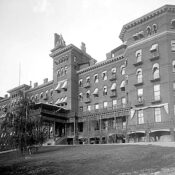The one thing we know about this year’s Democratic convention is that expectations that people might have had a month ago have been turned upside down. The presumptive presidential and vice presidential nominees are now different, and there will likely be a number of other surprises in store. But no matter how unpredictable it may be, it won’t be as crazy as the convention of 1924.
Sixteen days long, 103 ballots, and 60 (60!) candidates. And they ended up choosing one who no one really wanted. It perfectly justified Will Rogers’ words, “I’m not a member of any organized political party….I’m a Democrat.”
There were two leading candidates for president that year. The one with the greatest support was William Gibbs McAdoo, a former treasury secretary and one of the founders of the Federal Reserve System. He had wanted to run in 1920, but was warned away from the convention by his father-in-law, President Woodrow Wilson. Now, McAdoo believed 1924 was his chance.

He was the choice of Democrats in the South and West, who regarded him as more conservative and sympathetic to rural voters. And they liked the fact that, like them, he supported prohibition.

Al Smith was a product of New York’s political machine. He supported reform in labor laws and worked to make government more responsive. He also spoke out against lynching and racial violence, which made him unpopular with some Democrats. He opposed prohibition, which had been a hard blow to New York’s restaurants, bars, and hotels. He was also Catholic, which raised objections with yet another player at the convention: the KKK.
The Ku Klux Klan was enjoying an unprecedented revival in 1924. In just nine years it had revived and gained nearly four million members. The Klan’s support was necessary for many politicians to get elected, and some elected officials actively supported the Klan’s racist agenda. It had a strong presence at the convention, which one journalist referred to as a “Klanbake.”
The Klan had become popular because it opposed Black Americans’ demand for civil rights. It also made life difficult for people its members considered insufficiently American. This included burning crosses in front of Catholic churches, assassinating a priest, lynching a Jewish business owner, and accusing both faiths of planning to take over the United States. Many white Protestant Americans approved of the Klan’s harassment of these groups.
The Klan backed McAdoo, who wouldn’t say if he was a Klansman. But he welcomed the Klan’s support and didn’t mind if it lost him the vote of Catholics.
On June 24th, Democrats from 48 states packed themselves into Madison Square Garden. The first order of business was to define the Democratic platform. An argument quickly arose between northeastern Democrats who wanted the party to condemn the Klan. Rural Democrats, including McAdoo, refused to include it. The angry divisions between delegates rose to the surface in shouting and boxing matches.

Once the party failed to make a decision about the Klan, it settled down to start the nomination process. Most expected the nomination to go to McAdoo on the first ballot, but that would not be the case. The first ballot produced 431 votes for McAdoo — more support than any other candidate. But this was only 38 percent of the vote, and still a far way from the 66 percent a successful candidate needed.
Smith received 22 percent of the vote, but his supporters believed if they just hung on, they could build a winning majority. The remaining 40 percent of ballots were spread among 17 other candidates.
The delegates passed on to a second ballot, with similar results. Then a third ballot. And a fourth.
Reporters noted that the heat of the day, combined with hundreds of agitated delegates, produced a furnace-like temperature in the hall. The crowd continually waved hats and fans for a little relief. But there was little cooling of tempers.
By the 15th ballot, the number of Smith supporters had risen to 27 percent. McAdoo had raised his percentage of delegates to 44 percent, still nowhere near 66 percent. Delegates were starting to become frustrated with the two dominant candidates.
On the tenth day of the convention, 20,000 Klan members gathered in New Jersey to burn crosses and effigies of Smith.
By the 30th ballot, McAdoo had lost three points, and Smith had gained two. By now arguments and confrontations on the floor were turning ugly. As the days passed and delegates endured the heat and fog of tobacco smoke, there was shouting, screaming, fistfights, and profanity aplenty.
Uploaded to YouTube by historycomestolife
Many at the convention had already begun thinking that a compromise candidate was the only way they escape this long torment.
There had been little movement by the 60th ballot, which set a new record for number of ballots at a convention. Some candidates had been added to the list. Others had dropped off, but Smith and McAdoo didn’t budge. The closest McAdoo came to becoming the convention’s choice was the 77th ballot, when he received 48 percent of the vote. Smith finally pulled ahead of McAdoo on the 87th ballot. But he never got more than 32.8 percent of the vote. Finally, the McAdoo and Smith camps had had enough. Both pulled out of the race, and a compromise candidate was put forward and chosen on the 103rd ballot.

By this point, 58 alternative candidates had received votes, but John W. Davis had remained in third place through most of the balloting. With his nomination, the longest convention in American history came to an end.
Davis was a former solicitor general and ambassador, and the first southern candidate since the Civil War. He was formal, reserved, and awkward among voters.
He lost in a landslide to Calvin Coolidge, who had said and done little that voters could fault ever since succeeding to the office upon President Warren Harding’s death.
But the convention wasn’t a complete loss. There was one historical high point, and it was delivered by the man who nominated Al Smith.

Back in 1921, Franklin D. Roosevelt, who had recently lost the race for vice president, contracted polio. The nation learned it had rendered him unable to walk. But after years in rehabilitation, he had decided to resume what had been a promising political career. So, he strengthened himself until he could almost walk with braces on his legs. At noon on June 26th, the crowd was stunned to see Roosevelt, relying heavily on his son’s support, stagger upright to the podium. Holding tight to its sides, he gave a speech nominating Al Smith. It was the first time Roosevelt had spoken in public in three years, but here he was, sounding clear and strong. The delegates cheered at what seemed a miracle.
The party members soon fell back into bickering and scheming. It would carry the discord for another eight years when Roosevelt, as president, reunited a party that had nearly fallen apart in 1924.
Become a Saturday Evening Post member and enjoy unlimited access. Subscribe now




Comments
Fascinating article, Jeff. Yes, I would have to say the 1924 DNC was far worse than the 2024 that just ended last week. It had been predicted to be as bad as 1968, but wasn’t. The violence that did occur was mostly absent from the mainstream news media, just like so much else that’s “sanitized” now. It’s lies by omission on top of all the lies we’re told anyway.
So here, we have an unbearable 16-day political horror story in New York City, in sweltering heat (indoors) making everything so much more intolerable. KKK “Klanbakes” that included burning crosses in front of Catholic churches, assassinating a priest and lynching a Jewish business owner out of their unwarranted fear of either/both faiths taking over the U.S.
That’s not all here, by a long shot. The ‘D’ Party is as equally messed up today as is was in 1924 in different ways. It’s as opposite as you can get to putting the needs of the American people first. Both parties are one big warmongering uniparty whose only allegiance is to themselves and the military industrial complex keeping us in ‘forever wars’ they all profit from, with OUR money.
Nothing is too low or off the table for their quest for power, and retaining it. Weaponized lawfare by a current president to keep his opponent tied up in court for weeks on end, then last month a nearly successful assassination attempt on the same man.
Then the current president in ousted in a desperate coup because his own party didn’t like his chances of winning. THEN they anoint his replacement with a candidate they themselves wanted dumped just as badly up until this month. A lot of smoke and mirrors are currently being employed, but can only last so long, which likely won’t be much longer.
As for the Kennedy family’s current claims RFK Jr. is destroying the legacies of their father and uncle, they’re doing that all on their own by not denouncing this radicalized party that is NOT the party of JFK and RFK, at all. Truthfully, it’s a form of re-assassinating them all over again. This time though, it’s no witches brew of the FBI, CIA, LBJ and Castro.